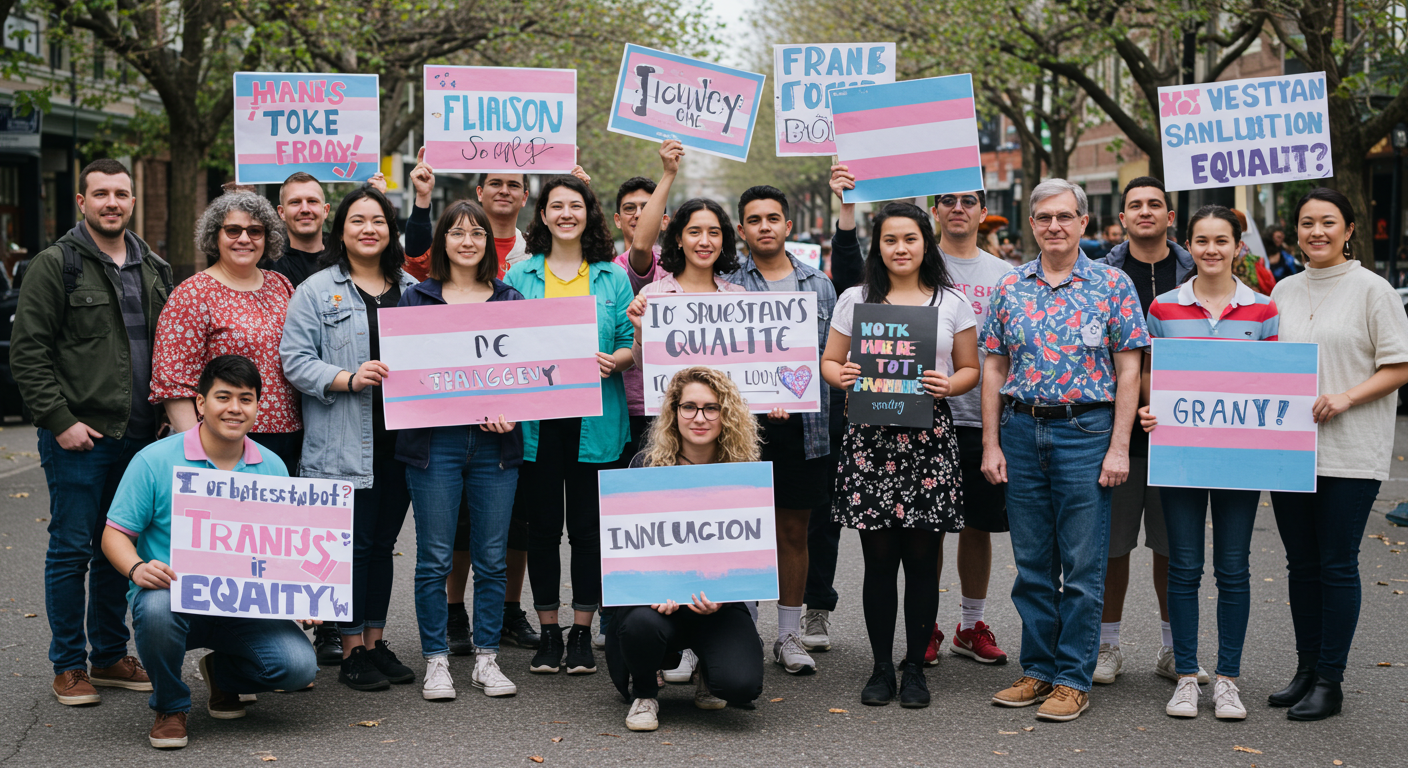Understanding and supporting transgender individuals is not only a matter of human rights—it’s a vital step toward building a more just and compassionate society. This content explores the multifaceted aspects of transgender advocacy, encompassing legal protections, everyday respect, education, community support, and the impact of personal stories. It highlights both the progress that has been made and the work that still lies ahead, offering insight into how individuals and institutions alike can contribute to lasting change. By recognizing the importance of inclusion, dignity, and action at all levels, we lay the groundwork for a more equitable world where everyone has the opportunity to live authentically and safely.
Understanding Transgender Advocacy: A Foundation for Social Progress
Transgender advocacy represents much more than public demonstrations or policy debates; it is a dynamic, ongoing commitment to ensuring that transgender individuals can live as their authentic selves without fear or limitation. Advocacy efforts include fighting for legislative protections, expanding access to healthcare, promoting supportive educational environments, and raising social awareness about gender diversity. The work of advocates often involves collaboration with a range of partners, from educators and healthcare providers to legal experts and grassroots organizers, all united by the goal of reducing barriers and amplifying the voices of transgender individuals. Throughout history, movements supporting transgender rights have achieved significant milestones, particularly in recent decades. These victories demonstrate the power of collective action in creating cultural shifts and advancing equity.
One of the most critical aspects of effective advocacy is highlighting local and national models that demonstrate best practices. Regions that adopt inclusive policies and provide proactive support serve as models for others to follow. For instance, Transgender Advocacy California emphasizes the importance of community involvement, showing how a network of advocates, allies, and organizations can promote lasting, meaningful change. As conversations continue to grow, both individuals and institutions must recognize that progress is built not only through high-profile campaigns but also through ongoing education, open dialogue, and sustained efforts at every level of society.
Recognizing Basic Rights: Why Legal Protections Matter
Legal protections are a foundation for the transgender community’s well-being. Rights enshrined in law, such as protections against employment discrimination, guarantees of equal access to healthcare, and the ability to update official documents, form the first line of defense against systemic inequality. While laws vary from region to region, their presence or absence can determine whether a transgender person can safely rent a home, gain meaningful employment, or access critical medical care without fear of prejudice. Unfortunately, in many parts of the world, gaps remain, and transgender individuals continue to face systemic barriers that leave them vulnerable to violence and economic hardship. As highlighted in a Human Rights Watch report, recognizing and upholding the rights of transgender people remains a global challenge, especially where legal frameworks are weak or nonexistent.
Recent years have seen significant progress thanks to the tireless efforts of advocates and community leaders. In some regions, anti-discrimination laws now explicitly include gender identity as a protected category. However, the fight is not over. With a shifting legislative landscape in many countries, ongoing vigilance and advocacy are crucial to defending wins and expanding coverage to everyone. The stories of change are a testament to the importance of having legal frameworks that reflect the shared values of fairness and justice. However, those stories also highlight that passing a law is just the beginning, as implementation and cultural acceptance must follow.
Dignity and Respect: Fostering Acceptance in Everyday Life
While laws play a vital role, everyday actions by individuals can be just as impactful in creating a welcoming environment. Using someone’s correct name and pronouns is not only a sign of respect; it is a core affirmation of their identity and humanity. Small yet meaningful gestures help to create workplaces, schools, and communities where everyone can thrive. Even when well-meaning, mistakes around pronouns or names can be uncomfortable, but they offer opportunities to apologize, learn, and grow. Encouraging sensitivity and cultural competence in daily interactions can reduce anxiety and promote psychological well-being for everyone.
Transgender individuals frequently encounter specific obstacles in day-to-day life, such as barriers to healthcare, exclusionary school dress codes, and ignorant or biased workplace policies. Allies—whether friends, colleagues, or neighbors—play a crucial role in breaking down these barriers by challenging hurtful comments, supporting policy changes, and learning about the community’s needs. When efforts are made to center dignity and respect across all settings, the effect is transformative, not just for individuals but for society as a whole.
Realities of Discrimination: Data and Personal Stories
Experiences of discrimination are not isolated incidents; they are part of a pattern that has been documented extensively by research. As highlighted by Human Rights Campaign data on the transgender community, approximately half of transgender people have reported facing discrimination within the last year, whether in seeking a job, renting a home, or accessing services. This discrimination can have devastating ripple effects, contributing to higher rates of homelessness, poverty, and mental health issues. For example, transgender youth are significantly more likely than their peers to experience depression, anxiety, and suicidal thoughts due to a lack of acceptance and support.
Personal narratives add depth and urgency to these statistics. Consider the story of Jamie, a young transgender student who felt isolated at school due to gendered restroom policies. With encouragement from peers, Jamie started a petition and met with administrators to advocate for gender-neutral facilities. Their success not only improved life for transgender students but also fostered a sense of openness and community at school. These stories remind us that change is possible and that advocacy often starts with listening to others and amplifying their voices.
Best Practices for Supporting the Transgender Community
There are straightforward, meaningful ways to support transgender people on both individual and institutional levels. Businesses and schools can institute clear policies that explicitly include gender identity in their non-discrimination statements. Updating forms to allow for self-identification beyond the binary and providing access to gender-neutral restrooms are substantial steps toward inclusion. Healthcare providers can ensure that intake processes are respectful and affirming by offering training to all staff members on gender identity and respectful communication.
- Visibly demonstrate allyship, for example, through pronoun badges or safe-space stickers.
- Organize ongoing education sessions that foster understanding of gender diversity.
- Empower open and respectful conversations that demystify gender identity.
Understanding subtle forms of prejudice, known as microaggressions, is equally important. These everyday slights, whether intentional or not, can accumulate to create hostile environments. Being mindful of language and correcting mistakes in a supportive manner can help reduce the impact of microaggressions, demonstrating a sincere commitment to fostering a respectful community.
The Role of Education in Transgender Advocacy
Education is a cornerstone of social change and a critical part of any advocacy effort. The introduction of inclusive curricula in schools significantly reduces bullying and promotes acceptance by teaching students about gender diversity, civil rights history, and the stories of transgender people. Education does not just occur within classrooms; it extends to workshops, media, and everyday conversations at home and in the community. Reliable resources and continuing education opportunities help people challenge stereotypes and become informed allies who can help reshape the narrative.
When parents, students, and teachers are given access to factual, compassionate information about transgender experiences, acceptance increases and mental health outcomes improve markedly. Education is a catalyst for empathy—a quality that, when widely cultivated, can alter the trajectory of countless lives for the better.
Community Initiatives: Stories of Progress and Hope
Across the globe, local communities are developing creative and resilient responses to support transgender individuals and uplift their experiences. Grassroots programs have made a substantial impact—providing mentorship for transgender youth, launching health clinics with staff trained in sensitivity, and organizing pride celebrations that offer both visibility and solidarity. In some cities, career development workshops have been specifically tailored to address the needs of transgender people facing discrimination in the workplace.
Visibility in the media, participation in local government, and positive representation in the arts all contribute to broader social acceptance. When transgender people see their lives reflected in stories, news, and leadership roles, it increases their sense of safety, purpose, and belonging. Community-based advocacy demonstrates that every step forward, no matter how small, contributes to real and lasting change.
Looking Ahead: How to Stay Involved and Empower Change
Advocacy is not just a moment—it’s a movement. There are tangible actions everyone can take to keep pushing for progress:
- Support transgender advocacy groups and initiatives through donations, volunteering, or amplifying their messages on social media.
- Connect with local and national policymakers to advocate for inclusive laws and policies that protect the rights of transgender individuals.
- Engage in self-education about gender identity and share insights with friends and family, helping to build understanding in your community.
- Facilitate, join, or attend community events, support groups, or educational programs that promote respect and inclusion.
By remaining engaged, proactive, and open-minded, anyone can contribute to the ongoing pursuit of equality. Each step—however small—moves society closer to a future where every transgender individual enjoys the rights and dignity they deserve.

